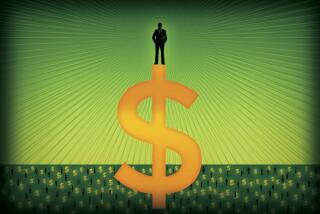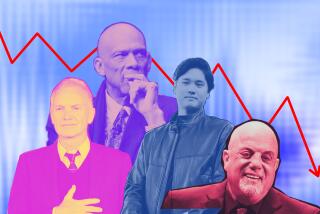CEOs Gorge, and Everyone Else Gets Sick
- Share via
Symptoms begin with gasps and a scalded windpipe. This is followed by nausea, rising fury, perhaps a glimmer of hope and, finally, creeping numbness. The syndrome, I think, is called UHB, the Unbearable Heaviness of Being.
After weeks or months, stray facts become blurs and the body’s circuit-breakers begin to shut down. We retreat into mystery novels, the politics of baseball, “MASH” reruns on television or hard drink. I’ve been slipping in that direction myself. It’s one thing if the scandal of corporate America is a case of a few bad apples, or even a truckload. But overload occurs if there’s something rotten in the orchard itself.
With the benefit of distance and a rousing enthusiasm for corruption, the British helped bring matters back into perspective last week. The Financial Times newspaper added up what happened to top executives of the 25 recent biggest U.S. corporation failures: They took home $3.3 billion in stock sales, bonuses and other perks before stiffing shareholders and creditors and dumping their messes in bankruptcy court.
Oh yes, 94,182 people were thrown out of work and investors lost $210 billion.
Nine of these corporate “Barons of Bankruptcy,” as the Financial Times called them, pocketed more than $100 million apiece while leading companies into insolvency.
So much for good work and just deserts, eh?
The trouble with these CEO atrocities, however, is that the numbers are almost too big to digest. My pocket calculator doesn’t have enough zeros to compute $100 million. And when I work the numbers out by hand, I’m not sure it really says enough to note that a person earning $7 an hour would have to work 6,868 years and a couple of weeks to make that much (you $100K employees could reach the mark in just a millennium).
By contrast, the Forbes 400 richest Americans accumulated wealth at the rate of $240,000 per hour in recent years, according to Jeff Gates, author of the book “Ownership Solution,” which seeks greater fairness in capitalism. CEOs, who earned 26 times the salary of an average worker in 1965, took home 310 times what they paid their workers in 2000, as calculated by the Economic Policy Institute.
For all the hot air in Washington about calling a halt to greed, however, the group Citizens for Tax Justice notes that George W. Bush’s 10-year income tax cut, still the law of the land, will mean a savings of $342,000 per person for the wealthiest 1% of Americans, leaving Social Security recipients to face the mess later.
Of course, the good life at the top doesn’t stop with stock options and bonuses. To hang on to their talent, corporations must make their executives comfortable, right?
We recently learned that Tyco spent more than $11 million to decorate an apartment for then-CEO L. Dennis Kozlowski. According to the Wall Street Journal, this included a now-notorious $6,000 “gold-and-burgundy floral patterned shower curtain” and $1 million or so for his wife’s 40th birthday party in Sardinia. I should hope so. After all, this chap was, again to quote the Journal, “a management guru who cracked the secret of running a successful, lean conglomerate.”
If you missed the story, let’s also mention that Kozlowski put his personal trainer, his doctor and favorite chef on the company payroll. Total: $135 million in company perks went to fatten Kozlowski so he could keep Tyco lean.
If it’s hard to digest what we’ve already learned without lapsing into terminal UHB, more really bad news looms on the horizon. Corporate executives have been fattening their earnings statements for years now--along with their performance bonuses and stock options--by projecting huge investment gains from their employee pension plans.
But now these plans are coming up short along with the rest of the economy. And I don’t know anybody with a calculator that has enough zeros to account for this ocean of red ink.
General Motors, for instance, faces $61 billion in uncovered liabilities for employee pensions and retiree health coverage, the New York Times wrote. Business Week reports that just three years ago, 78% of companies were sitting on fat surpluses in their pension funds. By the end of 2002, just about the same number will be in the red.
Experts have begun warning that the squeeze on these old-style pensions, not to mention the staggering losses to the modern 401(k)s, could be the defining financial crisis of this decade. It’s hard to imagine that worse is to come, isn’t it?
More to Read
Inside the business of entertainment
The Wide Shot brings you news, analysis and insights on everything from streaming wars to production — and what it all means for the future.
You may occasionally receive promotional content from the Los Angeles Times.










